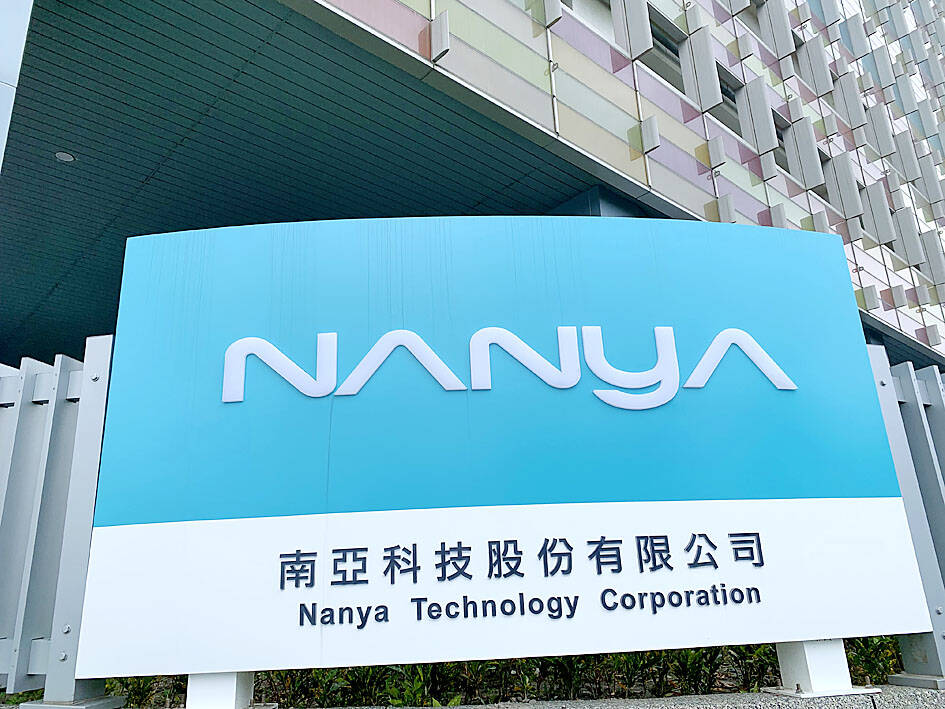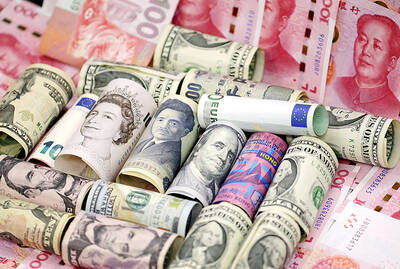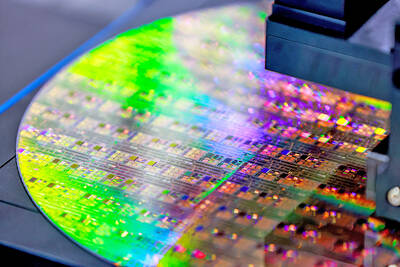DRAM chipmaker Nanya Technology Corp (南亞科技) yesterday reported its first quarterly profit in about three years as chip prices soared 40 percent sequentially amid thriving demand for artificial intelligence (AI) applications and scarce supply of mature chips for non-AI devices.
The company posted net profit of NT$1.56 billion (US$50.82 million) last quarter, from losses of NT$4.1 billion in the previous quarter and NT$1.49 billion in the third quarter last year, with earnings per share of NT$0.5.
Gross margin improved to 18.5 percent, compared with minus-20.6 percent in the second quarter and 3.2 percent a year earlier.

Photo: Grace Hung, Taipei Times
Shipments expanded more than 20 percent and revenue soared 78.4 percent from the previous quarter, the company said.
The significant improvement boosted the company’s confidence about business prospects for this quarter and next year. It yesterday raised its shipment growth forecast this year to 50 percent annually from a previous estimate of 40 percent.
“We are positive about the fourth-quarter outlook. We have high confidence that it will be a better period than the third quarter. Gross margin and profitability would continue to improve,” Nanya Technology president Lee Pei-ing (李培瑛) told an online earnings conference. “Next year will be a quite good year.”
Lee attributed the positive outlook to an anticipated increase in demand for DRAM chips next year, thanks to wider adoption of AI in servers, PCs, smartphones and robots.
This quarter, average selling prices of the company’s products are to climb from last quarter, he said.
The price rebound follows a three-year downward spiral for DRAM chips used in PCs, smartphones and consumer electronics, he said.
Almost every memory chipmaker was affected over the past three year as the emergence of OpenAI’s generative AI models and Nvidia Corp’s AI servers stimulated demand for high-bandwidth memory (HBM) chips, which made up just 9 percent of total memory shipments, he said.
Nanya Technology attributed a drastic price rebound last quarter to a supply crunch of less advanced DDR4 and low-power DDR4 chips as the world’s major memory makers allocated more capacity to produce lucrative HBM or DDR5 DRAM chips to meet booming demand.
It would take time, effort and costs to reallocate those capacities back to making DDR4 and low-power DDR4 chips, it said.
“The supply gap remains quite significant,” Lee said. “We are unable to fully catch up to customers’ demand. We are doing our best to increase production and to satisfy customer’s demand.”
DDR4 and low-power DDR4 chips made up more than half of Nanya Technology’s total shipments last quarter, DDR5 chips accounted for 10 percent, and the remainder was DDR3 and others, the company said.

Taiwan’s foreign exchange reserves hit a record high at the end of last month, surpassing the US$600 billion mark for the first time, the central bank said yesterday. Last month, the country’s foreign exchange reserves rose US$5.51 billion from a month earlier to reach US$602.94 billion due to an increase in returns from the central bank’s portfolio management, the movement of other foreign currencies in the portfolio against the US dollar and the bank’s efforts to smooth the volatility of the New Taiwan dollar. Department of Foreign Exchange Director-General Eugene Tsai (蔡炯民)said a rate cut cycle launched by the US Federal Reserve

The US government on Wednesday sanctioned more than two dozen companies in China, Turkey and the United Arab Emirates, including offshoots of a US chip firm, accusing the businesses of providing illicit support to Iran’s military or proxies. The US Department of Commerce included two subsidiaries of US-based chip distributor Arrow Electronics Inc (艾睿電子) on its so-called entity list published on the federal register for facilitating purchases by Iran’s proxies of US tech. Arrow spokesman John Hourigan said that the subsidiaries have been operating in full compliance with US export control regulations and his company is discussing with the US Bureau of

Businesses across the global semiconductor supply chain are bracing themselves for disruptions from an escalating trade war, after China imposed curbs on rare earth mineral exports and the US responded with additional tariffs and restrictions on software sales to the Asian nation. China’s restrictions, the most targeted move yet to limit supplies of rare earth materials, represent the first major attempt by Beijing to exercise long-arm jurisdiction over foreign companies to target the semiconductor industry, threatening to stall the chips powering the artificial intelligence (AI) boom. They prompted US President Donald Trump on Friday to announce that he would impose an additional

Pegatron Corp (和碩), a key assembler of Apple Inc’s iPhones, on Thursday reported a 12.3 percent year-on-year decline in revenue for last quarter to NT$257.86 billion (US$8.44 billion), but it expects revenue to improve in the second half on traditional holiday demand. The fourth quarter is usually the peak season for its communications products, a company official said on condition of anonymity. As Apple released its new iPhone 17 series early last month, sales in the communications segment rose sequentially last month, the official said. Shipments to Apple have been stable and in line with earlier expectations, they said. Pegatron shipped 2.4 million notebook